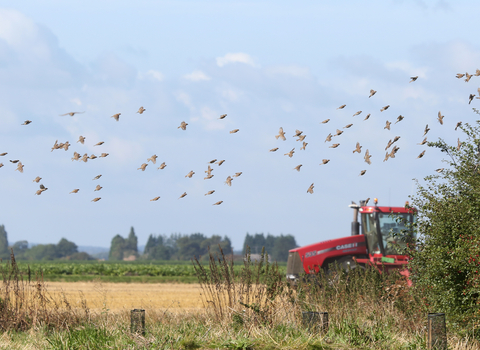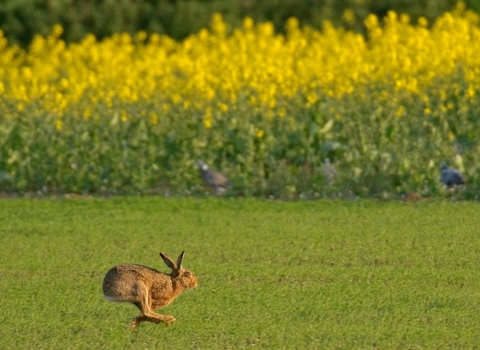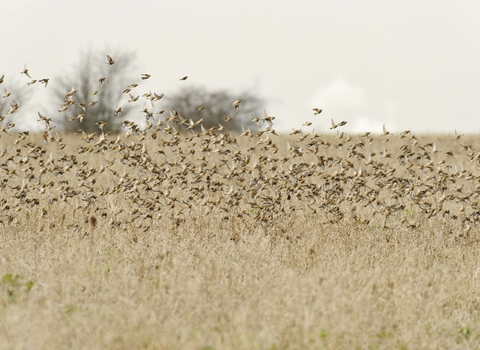Around 70% of land in England is used for farming. In the nature and climate crises that we face, where and how we use food has a huge impact on nature’s recovery.
More and more farmers are recognising the value of working with nature, not against it. These farmers and land managers are showing that farming doesn't have to harm nature.
Nature-friendly farming
Using nature-friendly farming methods leads to healthy soils, clean water, more wildlife - and resilient, profitable businesses which can better cope with challenges.
Nature-friendly farming includes types of farming such as organic, regenerative agriculture and permaculture. These farming methods work with nature rather than against it by:
- prioritising soil health and water conservation
- reducing and eliminating (as much as is possible) pesticides, herbicides and fungicides
- creating a healthy ecosystem, with a diverse range of plants and wildlife
- reducing waste
- supporting the local economy
If nature-friendly farming becomes the norm, there's huge potential to see wildlife and climate recovery. It could also boost local economies, create new jobs and see opportunities for innovation in rural areas. But to make this happen, we need system change.
Read The Wildlife Trusts' Farming Vision
Watch: regenerative agriculture in practice
Farming and food systems
Farming can benefit nature
The agricultural sector has a key role to play in nature and climate recovery. Nature-friendly farming approaches like regenerative and agroecological can be solutions to the climate and nature crises.
Regenerative farming allows the land, soil, water, nutrients and natural assets to regenerate themselves. An agroecology approach also covers the underlying research base and the supply chain.
More about farming and wildlife
Soil health is key
Our soils are key to farming, and to life. However, our soils are degraded. They are losing their ability to store carbon, hold water and grow food.
A food systems approach
Many of the drivers for harmful farm impacts happen beyond the farmgate, for example supply chains, processing, food waste and transport.
Our report explores 12 ways to tackle the food system to ensure nature and food production go hand in hand.
Read the food systems approach report
Our latest blogs and news
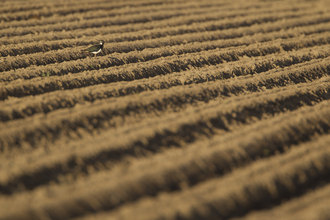
The Wildlife Trusts respond to independent Government review into farm profitability
Today, an independent review into farm profitability, led by Baroness Minette Batters, has been published.
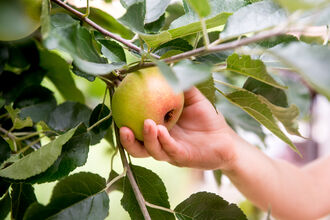
Can we afford nature-friendly food?
The cost of nature-friendly food is the subject of our next Wild LIVE panel event and a workshop at the Oxford Farm conferences, and at…

Nightmare before Christmas: worst environmental regression in decades looms
Labour’s list of broken promises mounts
Browse our farming blog posts Browse our farming news articles
Explore all our farming reports
Read The Wildlife Trusts' reports on farming and nature, along with the rest of our publications.
Managing our own land and farms
The Wildlife Trusts manage almost 100,000 hectares of land, and own working farms from lowland arable to upland hill farms which we manage for wildlife. We use these to demonstrate wildlife-friendly farming methods and several are managed in partnership with local farmers.
On our nature reserves we practice sustainable environmental land management using techniques such as conservation grazing. The Wildlife Trusts collectively own more than 7,500 grazing animals, including traditional and rare breed sheep and cattle, native ponies, red deer and even water buffalo. We also use local farmers to help manage wildlife sites. Grazing is the most natural form of management for certain habitats. Livestock can access areas that machinery can’t, and the impacts of grazing are slower than other methods, such as burning or cutting, which means that less-mobile wildlife can thrive.
Meet some amazing farmers!
Jonathan Boaz
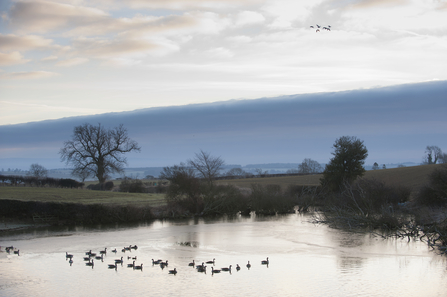
Paul Harris/2020VISION
Jonathan Boaz has been farming since 1968, taking over management of the farm, Mill Farm, Worcestershire in 1992, which now covers an amazing 600 acres. He has witnessed many changes in farming practises over the years, in particular the change in Government’s relatively new support for wildlife-friendly farming. Throughout his extensive career, Jonathan has discovered new, innovative ways to make a profit whilst also leaving room for nature to thrive. He has found ways to use as few chemicals as possible, whilst at the same time maximising soil fertility for crops of wheat. He doesn’t believe that we should rely on chemicals and has been able to reduce his need for them by using homemade compost, choosing crop varieties carefully and making changes to his rotation to manage weed and disease burdens. His logical but creative outlook on farming even saw him win the Arable Innovator Award at the British Farming Awards in 2016 and after 50 years of farming, he is still striving to find the best compromise between growing enough food for an ever-growing population, whilst still working closely with nature.
Jonathan says: “We need to be cautious of preserving our land for future farming generations. Too much intensive farming will only hurt us in the long run. We must find a way to scale back on chemical usage whilst also producing enough food for the ever-growing population.”
Tom Meikle
Tom Meikle is a Trustee of Worcestershire Wildlife Trust, as well as a farmer with a passion for nature and conservation. He’s been farming since 1986 in partnership with his wife and family, who have now owned Wick Grange Farm for three generations. Over the years, the farm has changed a lot. They’ve grown a range of crops, from wheat to barley, as well as rearing a variety of animals including cows and pigs. However, the one thing that’s remained consistent is Tom’s enthusiasm for nature-friendly farming. This interest is what initially attracted him to the Countryside Stewardship Scheme. This scheme worked well from both a business and a conservation perspective, allowing him to put in place several wildlife-friendly farming techniques.
The first thing that Tom implemented was wildflower field margins. These margins were used around every field and, almost overnight, there was a noticeable increase in birds and pollinators. Tom has always strived to look for solutions that solve both farming and conservation problems. One of the best examples of this is his use of old logs. Rather than burning them, which is harmful to the environment, he uses them to make a range of different log piles – a low-cost solution that benefits a whole host of wildlife! Other wildlife-friendly initiatives that Tom implements include building hibernaculum for newts and utilising wild seed mixes to increase the number of insects in order to support bird populations!
The Wildlife Trusts believe that by working together we can change the natural world, for the better
Advising farmers and land managers
We help wildlife to thrive on farms by providing advice and guidance to around 5,000 landowners each year. This often involves helping farmers to access grants and can also involve helping groups of farmers to restore and link habitats at a landscape-scale.
Facilitation Fund
Wildlife Trusts facilitate groups of farmers through the government’s Countryside Stewardship Facilitation Fund. This experience supports the evidence that good quality and trusted advice is essential to achieving and maximising the outcomes of environmental land management. For example farmers and growers in Worcestershire have received funding for a five year Facilitation Fund project to develop habitats and nesting sites for native pollinators. The group are working together to establish viable populations of wild pollinators (bumblebees, solitary bees, hoverflies, butterflies etc). The project, which is coordinated by Worcestershire Wildlife Trust audits land-holdings using a Wild Pollinator Health Check and suggests management changes to complement the farming practises of participants. Lessons learnt and good ideas are shared with the whole group through study days, site visits and training events.
Local Wildlife Sites
There are around 40,000 Local Wildlife Sites in England covering more than 700,000 hectares of land. Two thirds are in private ownership. Local Wildlife Sites provide refuges for a range of wildlife and act as stepping stones to link nationally important ecological areas.
As Local Wildlife Sites are often privately owned, they rely on the commitment of the landowners, farmers and volunteers who are prepared to carry out sensitive habitat management. Wildlife Trust advisors work with landowners and farmers responsible for Local Wildlife Sites to help them do this. Without such care and effort, a site will gradually decline and lose its diversity and abundance of species. The Wildlife Trusts latest survey (2018) revealed that of more than 6,500 local wildlife sites surveyed, 16% had been damaged or lost over five years, the majority of which relates to poor maintenance.
Water Quality
Wildlife Trusts across England are working with water companies to help improve water quality which is impacted by farming. For example, Severn Trent Water employs Wildlife Trust farm advisors across the Severn and Trent river catchments to advise farmers on how to reduce their use of metaldehyde. This is the powerful ingredient in slug pellets which is extremely difficult and expensive for water companies to treat as well as harming wildlife.

